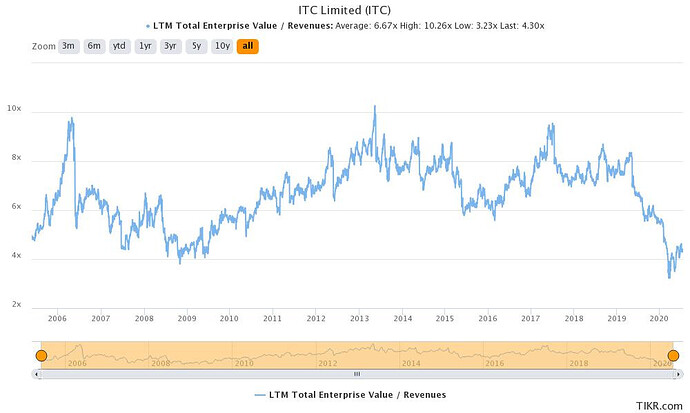I don’t build narratives to justify investing in a given company. I have shared my speculation on growth in ITC at the end of this post.
There are some flaws in your computation.
EBIT margin of 6% will imply PAT margin of ~4.5%. A 44 P/E (what’s the logic behind such a precise number?) implies valuation of 4.5 x 44 ~ 1.9x sales. This is almost the cost to build a brand. In private markets most good brands trade b/w 4-6x EV/sales. So I think the FMCG business is much more valuable than the value you are ascribing. Also, I will not ascribe such a high valuation for their hotel division.
The EBIT margin for ITC should increase (as has been increasing in the past) and stabiliize at 14-16% kind of levels over the next few years, as branding spends come down and the newer capacities run at optimal utilization. The margins might not go to 20%+ (like HUL, Nestle) because of ITC’s large presence in atta segment which is a lower gross margin business. The main difference in ITC’s business is their integrated nature, where they do everything in-house rather than outsourcing manufacturing. This leads to lower capital efficiency but a more resilient supply chain network. This is similar to what bulk food companies like KRBL, Adani Wilmar do.
About the branded spends in relation to sales, I think we should exclude cigaratte revenues for ITC. If we do a like-to-like comparison for FMCG sales, ITC’s FMCG revenues were ~14’757 cr. in FY21 (similar to nestle) and they spent 300 cr. additional on advertising over Nestle.
About your detailed valuation work
By doing some variant of SOTP, you are arriving at a Mcap of 276’084 cr. for close to 60’000 cr. of sales (FY22E). If we take away cash of 25’000 cr., EV ~ 251’084 cr., this implies EV/sales 4.18x. ITC has broadly traded b/w 4-10x EV/sales over their history. So the current valuation is towards the lower end for their traded history. Just 4 years back, they were trading at 9x+ EV/sales. So there has been a 50%+ de-rating, this can also change in the future where they are re-rated back to a 8x EV/sales.
In my personal investing journey, I have seen this de-rating and re-rating happen quite regularly among large cap companies. When I was buying HCL Tech and Infy in 2017, valuations had de-rated to 2-2.5x EV/sales, and then re-rated back to 4x+ EV/sales in 2021. They were good businesses in 2017 and in 2021, its just that market sentiments changed over this time period. I have had similar experiences in other large cap companies (like Airtel, Bajaj auto, L&T, HDFC, HDFC bank, etc.). I find this sort of investing very easy, where you buy very well known companies when market has lost fancy for them (thus at cyclical low valuations), wait for a few years (and maybe a new bunch of investors) and sell them when they are valued appropriately. Lets see if it happens with ITC.
ITC Projections (as on 01.06.2021)
FY21 sales: 53’155 cr., After five years, revenues will grow at 10%: 85’606 cr. I want to sell it at EV/sales > 8 (implies a P/E of 32 on cyclical high net profit margins of 25%): 684’848 cr.; Assuming a 25’000 cash balance, Mcap ~ 709’848 cr. Current share count: 1230.88 cr., assuming 0.6% share count dilution in-line with history, share count: 1238.27 cr. (share price ~ 570)
Confidence in projection (High)
- Business quality (high/medium/low): High (Generated 20%+ ROE/ROCE and FCF each year)
- Promoter quality (high/medium/low): High (Detailed reasoning below)
- Financial projections (high/medium/low): Medium (Should be able to grow sales at 10%+ in a normalized scenario)
- Valuation projections (high/medium/low): High (Has traded at >8x EV/sales multiple times in history)
- Is it a cyclical business (Yes/No): No
Management quality (High, ignoring lower cigarette growth rates)
- Organic sales growth greater than category level growth: No (Cigarette business growth has been lower than peers, FMCG growth has been higher than industry)
- Able to find new avenues to grow: Yes (Were able to diversify into FMCG)
- Treats minority shareholders in a fair manner: Yes (80%+ dividend payout)
| Companies |
Ticker |
Projection date |
Price |
4 years fwd Price (FY25) |
Price return % |
Dividend yield % |
Total returns % |
FY25 EPS double over FY21 |
Business |
Promoter |
Financial proj. |
Valuation proj. |
Cyclical? |
| I T C Ltd. |
nse:itc |
01.06.21 |
225.95 |
570.00 |
26.03% |
4.76% |
30.79% |
No |
High |
High |
Medium |
High |
No |
Summary: My expected IRR is in excess of 26% and I have very high confidence in my projections, thus this comes in the 8% weightage bucket.
Hope this clarifies my thought process. Thanks for the detailed note 


